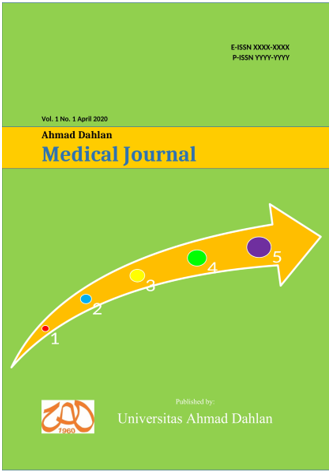Hepatoprotective Effects Of Papaya Leaves Extract (Carica Papaya L.) With Increased Dose: A Study Of Total Bilirubin Levels Of Wistar Rats That Given Paracetamol
DOI:
https://doi.org/10.12928/admj.v2i2.5063Keywords:
Papaya leaves; Ethanolic Extract; Total bilirubin levels; Paracetamol; HepatoprotectiveAbstract
Incorrect use of paracetamol can cause overdose and cause liver damage. Papaya leaves is a plant that has the potential as hepatoprotective because it contains flavonoids, saponins, tannins, alkaloids, triterpenoids and vitamin E. The aim of this study was to prove the hepatoprotective effect of papaya leaf extract on the total bilirubin levels of Wistar rats given paracetamol. This research was conducted using a post test only control group design method and used 24 wistar rats grouped by simple random sampling into negative control (K-), positive control (K +), treatment 1 (PI), and treatment 2 ( PII). PI and PII groups were given papaya leaf extract 75 mg / kgBB rats / day and 150 mg / kgBB rats / day for 7 days. On days 5 to 7, the K +, PI, and PII groups were given paracetamol 600 mg / kgBW rats / day. Samples were taken on day 8 and total bilirubin levels were measured on day 9 then analyzed using One Way Anova and Post Hoc LSD test. There are significant differences in all groups based on the results of the One Way Anova test with p value= 0.000. The results of the LSD Post Hoc test showed significant differences in the K- group with K + (p = 0,000), K- with PI (p = 0.027), K + with PI (p = 0,000), K + with PII (p = 0,000), PI with PII (p = 0.004), and there was no significant difference between the K- and PII groups (p = 0.397). There was a hepatoprotective effect of papaya leaf extract on Bilirubin total levels in Wistar rats treated with paracetamol.References
Afandi, M. (2017). Uji Antiinflamasi Ekstrak Etanol Daun Pepaya (Carica papaya Linn) Pada Tikus
Putih Jantan Galur Wistar yang Diinduksi Karagenin. Surakarta.
Boorman G, Suttie A, Leininger J, Eustis S, Elwell M, Bradley A, MacKenzie W. (2017). Boorman's
Pathology of the Rat. 2nd edition. Academic Press.
Hardiningtyas, S. D., Purwaningsih, S., & Handharyani, E. (2014). Aktivitas antioksidan dan Efek
Hepatoprotektif Daun Bakau Api-Api Putih. JPHPI, 17(1), 80-91.
https://doi.org/10.17844/jphpi.v17i1.8140
Hasan IL. (2014). Drug-Induced Liver Injury: Tantangan dalam Diagnosis. Contin. Med. Educ,
(3), 167-170.
Kamilah BR, Aminullah, A., Hadisaputro, S., Soemantri, A., & Suhartono, S. (2012). Kadar Oksidan
yang Tinggi Sebagai Faktor Risiko Terjadinya Hemolisis Pada Neonatus Sepsis. Sari Pediatri,
(3), 198–204. https://doi.org/10.14238/sp14.3.2012.198-204
Kasminah. (2016). Aktivitas Antioksidan Rumput Laut Halymenia durvillae dengan Pelarut Non
Polar, Semi polar dan Polar (Skripsi, Universitas Airlangga, Surabaya).
Lwanga S & Lameshow S. (2011). Sample Size Determintation For Health Study: A Practical
Manual, Geneva: WHO.
Mahatriny, N. N., Payani, N. P. S. , Oka, I. B. M. , Astuti, K. W. (2014). Skrining Fitokimia Ekstrak
Etanol Daun Pepaya (Carica papaya L.) yang Diperoleh dari Daerah Ubud, Kabupaten
Gianyar, Bali. Jurnal Farmasi Udayana, 3(1), 8-13
Qurrota, A., & Laily, A. N. (2015). Analisis Fitokimia Daun Pepaya (Carica papaya L.) di Balai
Penelitian Tanaman Aneka Kacang dan Umbi , Kendalpayak , Malang. 134-137.
Rehatta, N., Hanindito, E., Tantri, A., Redjeki, I., Soenarto, R., Bisri, D., Lestari, M. (2019).
Anestesiologi dan Terapi Intensif Buku Teks KATI-PERDATIN. Jakarta: PT Gramedia Pustaka
Utama.
Riset Kesehatan Dasar. (2010). Jakarta: Departemen Kesehatan Republik Indonesia.
Rosida, A. (2016). Pemeriksaan Laboratorium Penyakit Hati. Berkala Kedokteran, 12(1), 123–131.
Saputri, D. (2013). Pengaruh Pemberian Ekstrak Aseton Daun Pepaya (Carica papaya, L.) Sebagai
Hepatoprotektor Pada Tikus Putih (Rattus novergicus) yang Diinduksi Parasetamol (Skripsi,
Universitas Sebelas Maret, Surakarta).
Silvani, F. N., Sukohar, A., & Rudiyanto, W. (2019). Pengaruh Ekstrak Etanol Belimbing Wuluh
(Averrhoa bilimbi Linn) Sebagai Antioksidan Terhadap Histopatologi Hepar Tikus Galur
Sprague dawley yang Diinduksi Parasetamol. Majority, 8(1), 95-101.
Sunarni, T., Prastiwi, R., & Rinanto, Y. (2013). Kombinasi Ekstrak Etanol Buah Mengkudu (Morinda
citrifolia L.) dan Daun Pepaya (Carica papaya L.) Sebagai Hepatoprotektif Selama Pengobatan
Tuberkulosis. Ilmu Kefarmasian Indonesia, 11(2), 160-166
Downloads
Published
How to Cite
Issue
Section
License
Copyright (c) 2021 Adhani Rihhadatul 'aisy, Kanti Ratnaningrum, Dyah Mustika Nugraheni

This work is licensed under a Creative Commons Attribution-ShareAlike 4.0 International License.
License and Copyright Agreement
In submitting the manuscript to the journal, the authors certify that:
- They are authorized by their co-authors to enter into these arrangements.
- The work described has not been formally published before, except in the form of an abstract or as part of a published lecture, review, thesis, or overlay journal. Please also carefully read Ahmad Dahlan Medical Journal posting Your Article Policy.
- That it is not under consideration for publication elsewhere.
- That its publication has been approved by all the author(s) and by the responsible authorities - tacitly or explicitly - of the institutes where the work has been carried out.
- They secure the right to reproduce any material that has already been published or copyrighted elsewhere.
- They agree to the following license and copyright agreement.
Copyright
Authors who publish with Ahmad Dahlan Medical Journal agree to the following terms:
- Authors retain copyright and grant the journal right of first publication with the work simultaneously licensed under a Creative Commons Attribution License (CC BY-SA 4.0) that allows others to share the work with an acknowledgment of the work's authorship and initial publication in this journal.
- Authors are able to enter into separate, additional contractual arrangements for the non-exclusive distribution of the journal's published version of the work (e.g., post it to an institutional repository or publish it in a book), with an acknowledgment of its initial publication in this journal.
- Authors are permitted and encouraged to post their work online (e.g., in institutional repositories or on their website) prior to and during the submission process, as it can lead to productive exchanges, as well as earlier and greater citation of published work.


